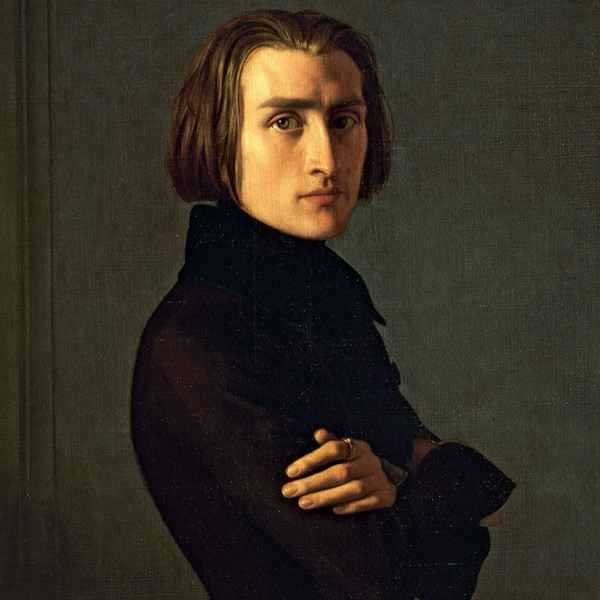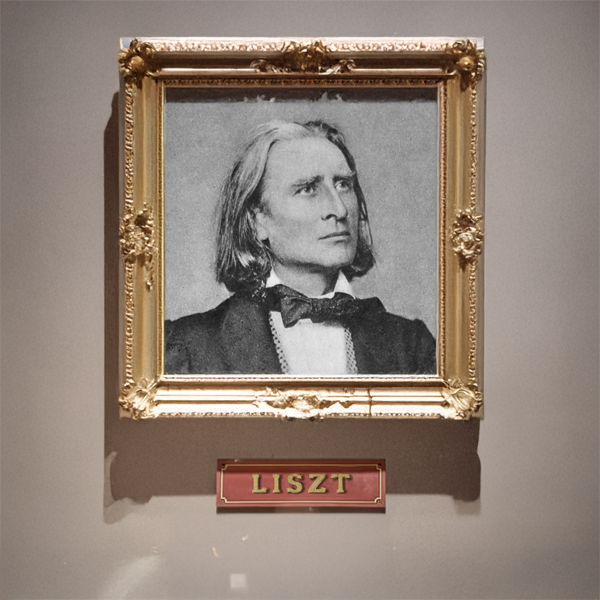Few composers in history have so profoundly shaped the course of music as Franz Liszt. A master pianist, composer, and visionary, Liszt was not only a defining figure of the Romantic era but also one of the greatest instrumentalists of all time. His dazzling technique, deep musical expression, and relentless innovation pushed the boundaries of what the piano could achieve.
Liszt’s music ranges from sweeping, transcendental études to intimate and poetic pieces, from his thunderous Hungarian Rhapsodies to his legendary Liebestraum. As a composer, he not only revolutionized piano music but also pioneered symphonic forms and inspired generations of musicians. Yet, despite his immense contribution to classical music, Liszt remains somewhat of an enigma—a figure of both brilliance and myth.
His influence even extends to my own compositions. In my piece Tahara, I explore a Liszt-esque left-hand technique—pressing down keys that are as far apart as possible, reminiscent of his legendary hand span and virtuosic style. The physicality and expressiveness of his piano writing continue to challenge and inspire musicians to this day.
Let’s embark on a journey through the life, works, and lasting legacy of Franz Liszt—a composer who not only played the piano but redefined it.
The Life of Franz Liszt
Early Life and Influences
Born in 1811 in the Kingdom of Hungary, Franz Liszt displayed exceptional musical talent from a young age. His father, Adam Liszt, was a musician who recognized his son’s potential and arranged for him to receive piano lessons. By the time he was a child, Liszt’s virtuosity at the keyboard was already astonishing, earning him opportunities to perform across Europe.

A famous photo of young Franz Liszt shows a serious, almost ethereal-looking boy—one who would soon take the music world by storm. His breakthrough moment came when, at the age of 19, he attended a performance by Niccolò Paganini, the legendary violinist. Completely awed by Paganini’s supernatural technical abilities, Liszt devoted himself to rigorous daily practice, often for 8 to 12 hours a day. He sought to push piano technique to new heights, much like Paganini had done for the violin, and this intense discipline laid the foundation for his later revolutionary compositions.
Family and Personal Life
Despite his larger-than-life public persona, Liszt’s personal life was deeply intertwined with the people he loved. Though he never officially married, he had significant relationships that shaped both his emotional and creative world.
His most famous romantic partnership was with Marie d’Agoult, a writer and intellectual. Together, they had three children, including Blandine Liszt and Cosima Liszt. Blandine led a relatively private life, while Cosima would go on to marry Richard Wagner, one of the most influential composers of the 19th century. Liszt’s complex relationship with Wagner—both as a mentor and later as a father-in-law—remains a fascinating part of music history.
Liszt as a Cultural Figure
Liszt was more than a composer; he was a symbol of the Romantic movement. His life and music embodied the passion, innovation, and deep personal expression that defined the era. His influence stretched beyond the piano, as he pioneered new symphonic forms, including the symphonic poem, a single-movement orchestral work that tells a story or paints a scene—an idea that would inspire composers like Richard Strauss and Claude Debussy.
His legacy is immortalized not only in music but also in the Budapest Ferenc Liszt International Airport, named in his honor. This recognition reflects how deeply he is ingrained in Hungarian culture, even though his influence extends far beyond his homeland.
From his early years as a piano prodigy to his revolutionary contributions to music, Liszt’s life was one of constant transformation and artistic innovation. He was not just a virtuoso—he was a musical force that reshaped the very fabric of 19th-century composition.
Liszt as a Composer and Pianist
Virtuosity and Style
As both a composer and a pianist, Franz Liszt was one of the most transformative figures in classical music. His music is characterized by technical brilliance, deep emotional expression, and groundbreaking harmonic ideas, which continue to influence pianists and composers today.
A hallmark of Liszt’s compositions is his sheer virtuosity. His piano pieces often feature rapid octaves, arpeggios spanning the entire keyboard, and intricate hand crossings—all of which showcase an almost superhuman level of dexterity. One reason he could achieve such feats was his extraordinary hand size. Accounts suggest that Liszt’s hands were unusually large and flexible, allowing him to reach extreme intervals with ease. This physical advantage, combined with his relentless practice, enabled him to compose pieces that pushed the limits of piano technique.
What makes Liszt’s music even more remarkable is that it wasn’t just about flashy technique. He infused his works with poetic depth, making them as expressive and lyrical as they were technically demanding. His ability to combine both elements set him apart from many of his contemporaries.
Piano Works and Techniques
Liszt’s piano music is among the most challenging ever written, with pieces that continue to test even the greatest pianists. His Transcendental Études, for example, are towering technical showpieces designed to push the performer to their absolute limits. These études—originally conceived as student exercises—were later expanded into twelve monumental works that require incredible stamina, speed, and expressive control.
To display his mastery at the piano, Liszt composed these études as a way to redefine what was possible on the instrument. Titles like Mazeppa and Feux follets (Will-o’-the-Wisps) reflect both the technical fire and poetic imagination behind these works.
The word “transcendental” in the title isn’t just a reference to technique—it also speaks to Liszt’s belief that music should go beyond mere notes and become an almost spiritual experience. His Transcendental Études are the perfect example of this philosophy in action, blending purely technical demands with profound artistic expression.
Liszt’s contributions to piano music and performance revolutionized the instrument, inspiring generations of composers and pianists. His legacy as both a visionary composer and a legendary virtuoso remains unmatched.
Famous Works and Notable Pieces
Iconic Piano Works
Franz Liszt’s piano compositions remain some of the most technically demanding and emotionally profound pieces ever written. Among his most celebrated works is the Sonata in B Minor, a masterpiece that defies conventional sonata form with its continuous, interconnected structure. This composition showcases Liszt’s ability to blend virtuosity, lyricism, and deep thematic transformation, making it one of the greatest piano sonatas of all time.
Another highlight of his repertoire is Années de pèlerinage (Years of Pilgrimage), a collection of three suites inspired by Liszt’s travels through Switzerland and Italy. These pieces, filled with poetic imagery and dramatic landscapes, reflect his profound connection to literature, nature, and spirituality.
Liszt’s Consolations are a more intimate side of his artistry. The third piece, Consolation No. 3, stands out for its soothing, song-like melody, reminiscent of Chopin’s nocturnes. Meanwhile, Un Sospiro is not just a beautifully flowing étude, but also a brilliant exercise in hand-crossing technique, demonstrating Liszt’s ability to merge technical innovation with expressive depth.
Most Recognized Compositions
One of Liszt’s most beloved works is the Liebesträume (Dreams of Love), a set of three piano pieces. The most famous, Liebestraum No. 3, is a hauntingly lyrical nocturne that has been transcribed for various instruments and remains a staple of romantic piano repertoire. The flowing arpeggios and heartfelt melody make it one of the most recognizable and frequently performed piano pieces in history.
If you’re looking to explore Liebestraum No. 3 further, you can find its sheet music widely available, making it an excellent piece for both professional pianists and students aiming to master Liszt’s expressive phrasing and delicate touch.
Technical Masterpieces
Liszt’s virtuosic showpieces pushed piano technique to new heights. Among them, La Campanella, based on Paganini’s violin piece, is one of the most challenging compositions ever written for piano. Its sparkling bell-like theme, rapid leaps, and delicate trills make it a true test of agility and control.
Similarly, Hungarian Rhapsody No. 2 is an electrifying mix of folk melodies, dramatic contrasts, and fiery technical demands. It has become synonymous with virtuoso piano performance and has been frequently adapted into films, cartoons, and popular culture.

Liszt’s Mephisto Waltz No. 1, inspired by the legend of Faust, is a dark, exhilarating composition that captures the devilish energy of Mephistopheles himself. The piece is filled with demonic runs, sensuous harmonies, and frenzied dance rhythms, making it one of Liszt’s most theatrical and thrilling works.
Another dazzling étude, Mazeppa, is based on Byron’s poem about a man tied to a wild horse. The piece features rapid octaves, relentless energy, and stunning dynamic shifts, embodying the sheer drama and heroism that Liszt was known for.
Liszt’s Influence and Legacy
Impact on Music and Culture
Franz Liszt’s influence extends far beyond his own compositions—he reshaped the role of the pianist, the structure of compositions, and the very nature of performance itself. His pioneering use of thematic transformation, where musical ideas evolve across a piece, directly influenced later composers like Richard Wagner, Gustav Mahler, and Claude Debussy.
Liszt also elevated the status of the concert pianist, turning performances into dramatic, highly expressive events. His flamboyant stage presence, dazzling technique, and innovative approach to interpretation inspired the modern concept of the piano virtuoso. Without Liszt, the modern solo recital as we know it—where a single performer takes the stage for an entire evening—might not exist.
His cultural influence is still present today. From classical concerts to movie soundtracks, Liszt’s music remains widely recognized. If you’re looking to experience his work firsthand, take a moment to listen to Franz Liszt’s recordings, whether performed by legendary pianists like Horowitz and Argerich or through modern interpretations.
Interestingly, Liszt’s legacy also lived on through his children, including Daniel Liszt and Cosima Liszt. While Daniel tragically passed away young, Cosima went on to marry Richard Wagner and played a major role in shaping the future of classical music. This family connection further cemented Liszt’s influence on the Romantic era and beyond.
Liszt’s innovations paved the way for future generations of musicians, ensuring that his legacy endures. His works challenge pianists to this day, while his expressive depth continues to captivate listeners worldwide.

